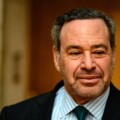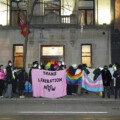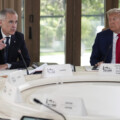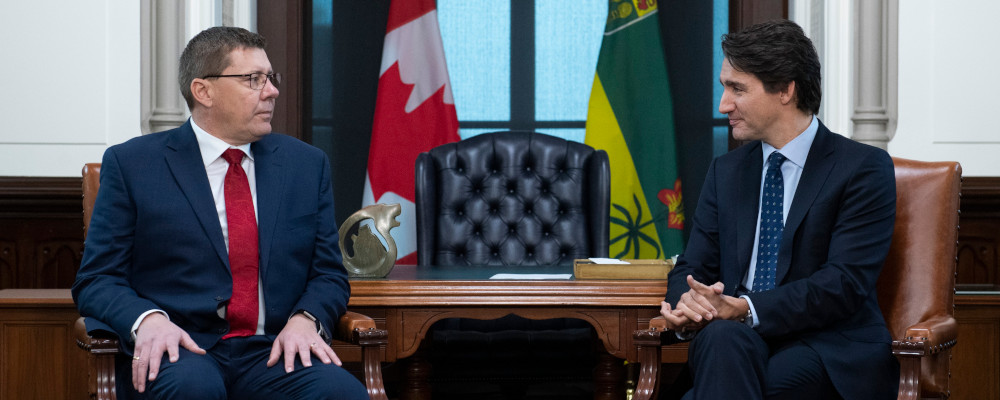Part I:
This is an essay in three parts. Part II will run tomorrow, Tuesday, and Part III on Wednesday.
While Alberta’s constitutional convulsions have received most of the national attention, for several years Saskatchewan has been quietly asserting its own claims to provincial autonomy. This culminated two weeks ago in a government white paper titled “Drawing the Line: Defending Saskatchewan’s Economic Autonomy.”
Much of the report is taken up with recounting the province’s historical fight against the federal government to own and control its natural resources, but its purpose is to remind the reader that the fight is not over. Today, it says, the challenge is intrusive environmental regulations that, while claiming a federal purpose, vitiate the province’s right to manage and export its natural resources, as enshrined in 1982 in section 92A of the Constitution.
To defend its rights and interests, the report says that it is “exploring all options to fully assert our existing powers, rights and privileges under the Constitution.” It even hints at something like the Alberta Sovereignty Act—”Provincial legislation to clarify and protect constitutional rights belonging to the province”—but the Government of Saskatchewan seems to want to wait to see how that plays out next door before committing itself to a definite course of action.
That combination of courage and caution runs through the white paper. While it is billed as an emphatic proschema to Ottawa, its ultimate recommendations are tentative and couched in caveats and equivocations. By the time you reach the end, the defiant title has fizzled to a short list of “next steps and ways in which the province could conceivably defend and act to assert greater autonomy in Confederation.” It is a journey from provocation to polite suggestion in 24 pages. An exercise in audacious prudence.
What follows is a digression on the style of the white paper. My main intent in this article is to defend the case for provincial autonomy, but I cannot resist a few words about how the shoddiness of the document undermines its case. Skipping this section will not affect the argument, which continues after it.
“Drawing the Line” is a new low in political communications in Canada. It is doubtful that any government in the history of Confederation—federal, provincial, or municipal—has published something so badly written. My first thought was that an early and unedited draft had been posted prematurely, but after almost a week it has not been replaced. The text is not so much spoiled by errors as composed of them and the run-on sentences meander more than the South Saskatchewan river.
Consider, for example, this paragraph on page 3, which makes a good case for radical educational reform in the province, at least when it comes to literacy:
As perceived by Saskatchewan’s earliest leaders, such as Fredrick Haultain, the last Premier of the Northwest Territories before Saskatchewan became a province, said ‘all of our public revenues go to swell the Consolidated Revenue Fund of Canada, our public domain is exploited for purely federal purposes, and we are not permitted to draw on our future.’ The ambition was to build and develop the province as a place people wanted to flock too, as set out in Premier Walter Scott’s vision, another early leader and visionary for Saskatchewan. The potential for Saskatchewan to be more than a territory within Canada was not lost on future commentators and politicians.”
Or try to grope your way through this obscure paragraph on page 14. There have been more transparent prairie dust storms.
An example few local ranchers raised on the effectiveness of telling our story to the rest of Canada was around the proposed, and eventually withdrawn, Health Canada rules on beef labelling. The public outcry from local producers in western Canada culminated in cattle raisers sharing their narrative on how devastating such federal rules and requirements would be on local operations but also how responsible and beneficial their products are for Canadians. The feeling was that this needs to continue more to assert our autonomy and express how sustainably our oil and gas and agri-food products are made to the rest of Canada to highlight Saskatchewan’s position and defend our local interests, economy and the livelihoods of our residents.
It has been said that government communications should aim for a Grade 8 level of reading comprehension, but rarely do you see government communicating at a Grade 8 level of composition. At times the report reads like the original draft in Finnish was run through Google translate; at other times it barely reads at all. I refuse to believe that anyone old enough to bike to school was responsible for a sentence like: “While our land and province may no longer be considered new, you can still find the prosperous people in both urban and rural communities as the mayor of Regina said over a century ago.”
These are not the only examples. Even Homer nodded, so a government copyeditor may be excused the occasional lapse, but the text goes on like this page after semi-literate page. The reader must hack through a grammatical jungle to follow the path of the argument. If the Government of Saskatchewan wants its ideas to be taken seriously, it should start by expressing them in something more than pidgin English.
End of digression.
The most interesting part of “Drawing the Line” is its repeated invocation of Quebec as a model for Saskatchewan. References to how Quebec operates within Confederation appear no fewer than seven times. Here is a typical (and mostly lucid) example, summarizing the input from town halls held across the province last summer: “In discussing autonomy specifically, participants often highlighted an ask for the province to act more like the Province of Quebec. Namely, a government and province that acts instead of asks permission to defend its interests.”
This is not a new idea. Both Jason Kenney and Danielle Smith in Alberta have used Quebec as an example to justify a more assertive use of provincial powers. But the report goes further than suggesting that Saskatchewan act more like Quebec. Early on, it quotes a tweet from Premier Scott Moe last November that said: “Saskatchewan needs to be a nation within a nation.” This may be the most interesting political statement in recent Canadian history, but the report makes no attempt to explain it, let alone justify it. If anything, the report undercuts the force of Moe’s claim by suggesting that it just means that Saskatchewan needs to emulate “how the Province of Quebec operates with broader powers within Confederation.”
But acting like a nation and being a nation are very different things. I don’t expect the monkeys at the keyboard who drafted the white paper to appreciate this, but Moe is a serious and thoughtful leader, so it is worth taking his original words thoughtfully and seriously. The first thing to note is that Moe did not claim that “Saskatchewan is a nation within a nation.” Saying that “Saskatchewan needs to be a nation” is an aspirational, possibly hortatory, statement. It assumes that the province is not already a nation.
This prompts an obvious question: How does a non-nation become a nation? And a more basic question: What is a nation? The answer to those questions begins with recognizing that, despite the loose way we often use the terms, a nation is not the same thing as a country—or a province. It doesn’t help that, because we don’t have a common adjectival form of the word “country,” we talk of “national borders” and “national interests” when we mean the borders and interests of a country or of a state. But this confuses the fact that some nations are sovereign states and some are not.
The obvious example of this for Canadians is Quebec. Or rather, “the Québécois.” The motion proposed by Mr. Harper and passed by the House of Commons in 2006 said: “That this House recognize that the Québécois form a nation within a united Canada.” Interestingly, it is the people of Quebec (or perhaps some of them)Recall the dispute between Gilles Duceppe and Lawrence Cannon in 2006 over who is and is not a Québécois and whether the term has an ethnic component. Around the same time, Jean Charest further complicated matters by insisting that First Nations within Quebec were included among the Québécois, raising the idea of multiple overlapping and possibly inconsistent national identities for the members of Canada’s 617 First Nations, including 70 in Saskatchewan and 39 in Quebec. who are recognized as a nation, rather than the province. This distinction was reinforced in 2021 when the House again approved a motion that included the claim that “Quebecers form a nation”—language taken from Quebec’s own Bill 96.
Designation of the Québécois, but not the province of Quebec, as a nation complicates Moe’s plans to achieve nationhood for his province. On the one hand, recognizing Saskatchewan as a nation would be a first within Canada; on the other hand, if he truly wants to follow Quebec’s example, he will have to explain why Saskatchewanians constitute a distinct people who deserve to be recognized as a nation.
You might say, of course, that the distinction between the Québécois people and the provincial government that acts on their behalf (through a national assembly, no less) is semantic and that, for all practical purposes, the province of Quebec and the Québécois nation are coterminous.In 2006, Gilles Duceppe insisted that a Québécois was simply someone who lives in Quebec. In one sense, this is clearly illogical, for if an Albertan who was transferred by his employer to Quebec this morning is a Québécois, then there is nothing that makes being Québécois distinct from being Albertan. Duceppe can only be correct if we allow for some fudging between the core identity of a people and the complicating realities of immigration so that applying the term Québécois to someone who arrived yesterday is a convenient fiction that does not affect the central case of a Québécois as someone who speaks and is accultured in a distinct way. As noted in the previous footnote, the case of First Nations in Quebec raises even more questions about Duceppe’s sweeping definition. But if “nation” just means “province,” then what is gained by saying Saskatchewan should be a nation when it is already a province? The answer must be that a nation is something more than a province (or a country). Assuming this is true (and it is), then what is it that makes the Québécois (or Quebec) specially entitled to nationhood?
In Part II, I will consider the answer to that question and what it means for Canadian federalism. Then, in Part III, I will explain why the nation-province distinction shouldn’t matter for the practical working of Canadian federalism.
Recommended for You

‘There are consequences to this legislation’: Michael Geist on why the Canada-U.S. digital services tax dustup was a long time coming

Rudyard Griffiths and Sean Speer: The future of news in Canada: A call for rethinking public subsidies

‘You have to meet bullying with counter-bullying’: David Frum on how Canada can push back against Trump’s trade negotiation tactics

‘Our role is to ask uncomfortable questions’: The Full Press on why transgender issues are the third rail of Canadian journalism




